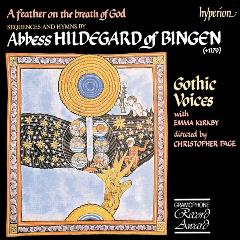Hildegard von Bingen - Eine Feder auf dem Odem Gottes (1985)
Hildegard von Bingen - Eine Feder auf dem Odem Gottes (1985)

1.- Columba aspexit (Sequentia de Sancto Maximino) play
2.- Ave generosa (Ymnus de Sancta Maria)
3.- O ignis spiritus (Sequentia de Spiritu Sancto)
4.- O Ierusalem (De sancto Ruperto)
5.- O Euchari (De sancto Euchario Sequentia)
6.- O viridissima virga (De sancta Maria)
7.- O presul yere civitas (Sequentia de Sancto Dysibodo)
8.- O Ecclesia (De Undecim Milibus Virginibus) play
Emma Kirkby (soprano),
Gothic Voices,
Christopher Page - director
Blessed Hildegard of Bingen (German: Hildegard von Bingen; Latin: Hildegardis Bingensis) (1098 – 17 September 1179), also known as Saint Hildegard, and Sibyl of the Rhine, was a writer, composer, philosopher, Christian mystic, German Benedictine abbess, visionary, and polymath. Elected a magistra by her fellow nuns in 1136, she founded the monasteries of Rupertsberg in 1150 and Eibingen in 1165. One of her works as a composer, the Ordo Virtutum, is an early example of liturgical drama. Attention in recent decades to women of the medieval Church has led to a great deal of popular interest in Hildegard, particularly her music. Between 70 and 80 compositions have survived, which is one of the largest repertoires among medieval composers. Hildegard left behind over 100 letters, 72 songs, seventy poems, and 9 books. One of her better known works, Ordo Virtutum (Play of the Virtues), is a morality play. It is unsure when some of Hildegard’s compositions were composed, though the Ordo Virtutum is thought to have been composed as early as 1151. The morality play consists of monophonic melodies for the Anima (human soul) and 16 Virtues. There is also one speaking part for the Devil. Scholars assert that the role of the Devil would have been played by Volmar, while Hildegard's nuns would have played the parts of Anima and the Virtues.
In addition to the Ordo Virtutum Hildegard composed many liturgical songs that were collected into a cycle called the Symphonia armoniae celestium revelationum. The songs from the Symphonia are set to Hildegard’s own text and range from antiphons, hymns, sequences, to responsories. Her music is described as monophonic; that is, consisting of exactly one melodic line. Hildegard's compositional style is characterized by soaring melodies, often well outside of the normal range of chant at the time. Additionally, scholars such as Margot Fassler and Marianna Richert Pfau describe Hildegard's music as highly melismatic, often with recurrent melodic units, and also note her close attention to the relationship between music and text, which was a rare occurrence in monastic chant of the twelfth century. Hildegard of Bingen’s songs are left open for rhythmic interpreation because of the use of neumes without a staff.[28] The reverence for the Virgin Mary reflected in music shows how deeply influenced and inspired Hildegard of Bingen and her community were by the Virgin Mary and the saints.
Hildegarda z Bingen, niem. Hildegard von Bingen (ur. 16 września 1098 w Rupertsberg k. Bingen nad Renem, zm. 17 września 1179 w klasztorze Rupertsberg – frankońska anachoretka, wizjonerka, mistyczka, i uzdrowicielka. Reformatorka religijna, benedyktynka (od 1136 przeorysza), uznawana przez Kościół katolicki za świętą. Pierwsza kompozytorka, której biografia jest kompletna i dobrze udokumentowana.
Według Hildegardy, muzyka była czystym wspomnieniem raju, gdzie Adam wraz z aniołami śpiewał psalmy na cześć stwórcy. Uważała, ze śpiew powinien być nieodłączną częścią liturgii, gdyż był równie ważny jak modlitwa i przybliżał człowieka do zbawienia. Wierzyła, że twórcze natchnienie pochodzi wprost od Boga, i dzieło artysty jest w rzeczywistości boskim przekazem. Wierna własnym nakazom, skomponowała moralitet i liczne pieśni religijne (ale nie liturgiczne). W odróżnieniu od typowych wówczas śpiewów chorałowych, jej melodie były znacznie bardziej emocjonalne. W ostatnich dekadach XX wieku muzyka Hildegardy zyskała ogromną popularność.
download: uploaded yandex anonfiles 4shared solidfiles mediafire mega filecloudio nornar
Last Updated (Wednesday, 08 January 2014 10:36)








